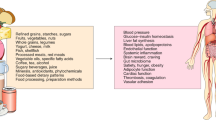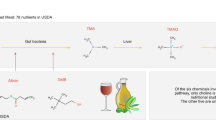Abstract
Background:
Nutrition science aims to create new knowledge, but scientists rarely sit back to reflect on what nutrition research has achieved in recent decades.
Methods:
We report the outcome of a 1-day symposium at which the audience was asked to vote on the greatest discoveries in nutrition since 1976 and on the greatest challenges for the coming 30 years. Most of the 128 participants were Dutch scientists working in nutrition or related biomedical and public health fields. Candidate discoveries and challenges were nominated by five invited speakers and by members of the audience. Ballot forms were then prepared on which participants selected one discovery and one challenge.
Results:
A total of 15 discoveries and 14 challenges were nominated. The audience elected Folic acid prevents birth defects as the greatest discovery in nutrition science since 1976. Controlling obesity and insulin resistance through activity and diet was elected as the greatest challenge for the coming 30 years. This selection was probably biased by the interests and knowledge of the speakers and the audience. For the present review, we therefore added 12 discoveries from the period 1976 to 2006 that we judged worthy of consideration, but that had not been nominated at the meeting.
Conclusions:
The meeting did not represent an objective selection process, but it did demonstrate that the past 30 years have yielded major new discoveries in nutrition and health.
This is a preview of subscription content, access via your institution
Access options
Subscribe to this journal
Receive 12 print issues and online access
$259.00 per year
only $21.58 per issue
Buy this article
- Purchase on Springer Link
- Instant access to full article PDF
Prices may be subject to local taxes which are calculated during checkout
Similar content being viewed by others
References
Addison W (1928). The uses of sodium chloride, potassium chloride, sodium bromide and potassium in cases of arterial hypertension which are amenable to potassium chloride. Can Med Assoc J 18, 281–285.
Adrogue HJ, Madias NE (2007). Sodium and potassium in the pathogenesis of hypertension. N Engl J Med 356, 1966–1978.
Age-Related Eye Disease Study Research Group (2001). A randomized, placebo-controlled, clinical trial of high-dose supplementation with vitamins C and E, beta carotene and zinc for age-related macular degeneration and vision loss; AREDS Report no. 8. Arch Ophthalmol 119, 1417–1436.
Ahrens EH, Hirsch J, Oette K, Farquhar JW, Stein Y (1961). Carbohydrate-induced and fat-induced hyperlipemia. Trans Assoc Am Physicians 74, 134–146.
Appel LJ, Moore TJ, Obarzanek E, Vollmer WM, Svetkey LP, Sacks FM (1997). A Clinical Trial of the effects of dietary patterns on blood pressure. Dash Collaborative Research Group. N Engl J Med 336, 1117–1124.
Astrup A, Grunwald GK, Melanson EL, Saris WH, Hill JO (2000). The role of low-fat diets in body weight control: a meta-analysis of ad libitum dietary intervention studies. Int J Obes Relat Metab Disord 24, 1545–1552.
B-Vitamin Treatment Trialists' Collaboration (2006). Homocysteine-lowering trials for prevention of cardiovascular events: a review of the design and power of the large randomized trials. Am Heart J 151, 282–287.
Bang HO, Dyerberg J, Nielsen AB (1971). Plasma lipid and lipoprotein pattern in Greenlandic West-coast Eskimos. Lancet 1, 1143–1145.
Barber B (1952). Science and the Social Order. Free Press: Glencoe, IL, Columbia University, New York.
Barker DJ (1990). The fetal and infant origins of adult disease. BMJ 301, 1111.
Beydoun MA, Kaufman JS, Satia JA, Rosamond W, Folsom AR (2007). Plasma n−3 fatty acids and the risk of cognitive decline in older adults: the Atherosclerosis Risk in Communities Study. Am J Clin Nutr 85, 1103–1111.
Beynen AC, Katan MB (1985). Why do polyunsaturated fatty acids lower serum cholesterol? Am J Clin Nutr 42, 560–563.
Bhattacharyya AK, Connor WE (1974). Beta-sitosterolemia and xanthomatosis. A newly described lipid storage disease in two sisters. J Clin Invest 53, 1033–1043.
Brecht B (1963). Leben Des Galilei. Suhrkamp Verlag: Frankfurt.
Brouwer IA, Geelen A, Katan MB (2006). n−3 Fatty acids, cardiac arrhythmia and fatal coronary heart disease. Prog Lipid Res 45, 357–367.
Brouwer IA, Zock PL, Camm AJ, Bocker D, Hauer RN, Wever EF et al. (2006). Effect of fish oil on ventricular tachyarrhythmia and death in patients with implantable cardioverter defibrillators: the Study on Omega-3 Fatty Acids and Ventricular Arrhythmia (SOFA) randomized trial. JAMA 295, 2613–2619.
Brussaard JH, Dallinga-Thie GM, Groot PHE, Katan MB (1980). Effects of amount and type of dietary fat on serum lipids, lipoproteins and apoproteins in man: a controlled 8-week trial. Atherosclerosis 36, 515–527.
Buck L, Axel R (1991). A novel multigene family may encode odorant receptors: a molecular basis for odor recognition. Cell 65, 175–187.
Connor WE, Connor SL (1997). Should a low-fat, high-carbohydrate diet be recommended for everyone? The case for a low-fat, high-carbohydrate diet. N Engl J Med 337, 562–563; discussion 566–567.
de Pee S, West CE, Muhilal, Karyadi D, Hautvast JG (1995). Lack of improvement in vitamin A status with increased consumption of dark-green leafy vegetables. Lancet 346, 75–81.
Desvergne B, Michalik L, Wahli W (2006). Transcriptional regulation of metabolism. Physiol Rev 86, 465–514.
Durga J, van Boxtel MP, Schouten EG, Kok FJ, Jolles J, Katan MB et al. (2007). Effect of 3-year folic acid supplementation on cognitive function in older adults in the FACIT trial: a randomised double blind, controlled trial. Lancet 369, 208–216.
Egger G, Swinburn B (1997). An ‘ecological’ approach to the obesity pandemic. BMJ 315, 477–480.
Eriksson KF, Lindgarde F (1991). Prevention of type 2 (non-insulin-dependent) diabetes mellitus by diet and physical exercise. The 6-year Malmo feasibility study. Diabetologia 34, 891–898.
Feder JN, Gnirke A, Thomas W, Tsuchihashi Z, Ruddy DA, Basava A et al. (1996). A novel MHC class I-like gene is mutated in patients with hereditary haemochromatosis. Nat Genet 13, 399–408.
Fox JC, McGill Jr HC, Carey KD, Getz GS (1987). In vivo regulation of hepatic LDL receptor mRNA in the baboon. Differential effects of saturated and unsaturated fat. J Biol Chem 262, 7014–7020.
Garland C, Shekelle RB, Barrett-Connor E, Criqui MH, Rossof AH, Paul O (1985). Dietary vitamin D and calcium and risk of colorectal cancer: a 19-year prospective study in men. Lancet 1, 307–309.
Heckers H, Goebel U, Kleppel U (1994). End of the coffee mystery: diterpene alcohols raise serum low-density lipoprotein cholesterol and triglyceride levels (letter). J Intern Med 235, 192–193.
Hetzel BS (2000). Iodine and neuropsychological development. J Nutr 130, 493S–495S.
Hirschhorn N, Kinzie JL, Sachar DB, Northrup RS, Taylor JO, Ahmad SZ et al. (1968). Decrease in net stool output in cholera during intestinal perfusion with glucose-containing solutions. N Engl J Med 279, 176–181.
Holick MF (2006). High prevalence of vitamin D inadequacy and implications for health. Mayo Clin Proc 81, 353–373.
Hunter DJ, Spiegelman D, Adami HO, Beeson L, Van den Brandt PA, Folsom AR et al. (1996). Cohort studies of fat intake and the risk of breast cancer—a pooled analysis. N Engl J Med 334, 356–361.
Huxley R, Neil A, Collins R (2002). Unravelling the fetal origins hypothesis: is there really an inverse association between birthweight and subsequent blood pressure? Lancet 360, 659–665.
Ioannidis JP, Ntzani EE, Trikalinos TA, Contopoulos-Ioannidis DG (2001). Replication validity of genetic association studies. Nat Genet 29, 306–309.
Jenkins DJ, Kendall CW, Marchie A, Faulkner DA, Wong JM, de Souza R et al. (2003). Effects of a dietary portfolio of cholesterol-lowering foods vs lovastatin on serum lipids and C-reactive protein. JAMA 290, 502–510.
Jenkins DJ, Wolever TM, Jenkins AL, Thorne MJ, Lee R, Kalmusky J et al. (1983). The glycaemic index of foods tested in diabetic patients: a new basis for carbohydrate exchange favouring the use of legumes. Diabetologia 24, 257–264.
Katan MB (2007). Does industry sponsorship undermine the integrity of nutrition research? PLOS Med 4, e6.
Katan MB, Willett WC, Grundy SM (1997). Beyond low fat diets. N Engl J Med 337, 563–566.
Kissebah AH, Vydelingum N, Murray R, Evans DJ, Hartz AJ, Kalkhoff RK et al. (1982). Relation of body fat distribution to metabolic complications of obesity. J Clin Endocrinol Metab 54, 254–260.
Klatsky AL, Friedman GD (1995). Alcohol and longevity. Am J Public Health 85, 16–18.
Knowler WC, Barrett-Connor E, Fowler SE, Hamman RF, Lachin JM, Walker EA et al. (2002). Reduction in the incidence of type 2 diabetes with lifestyle intervention or metformin. N Engl J Med 346, 393–403.
Knuiman JT, West CE, Katan MB, Hautvast JGAJ (1987). Total cholesterol and high density lipoprotein cholesterol levels in populations differing in fat and carbohydrate intake. Arteriosclerosis 7, 612–619.
Korver O, Katan MB (2006). The elimination of trans fats from spreads: how science helped to turn an industry around. Nutr Rev 64, 275–279.
Kovanen PT, Brown MS, Basu SK, Bilheimer DW, Goldstein JL (1981). Saturation and suppression of hepatic lipoprotein receptors: a mechanism for the hypercholesterolemia of cholesterol-fed rabbits. Proc Natl Acad Sci USA 78, 1396–1400.
Kromhout D, Bosschieter EB, De Lezenne Coulander C (1985). The inverse relation between fish consumption and 20-year mortality from coronary heart disease. N Engl J Med 312, 1205–1209.
Lew EA, Garfinkel L (1979). Variations in mortality by weight among 750 000 men and women. J Chronic Dis 32, 563–576.
Lin J, Handschin C, Spiegelman BM (2005). Metabolic control through the PGC-1 family of transcription coactivators. Cell Metab 1, 361–370.
Martinez ME, Giovannucci EL, Colditz GA, Stampfer MJ, Hunter DJ, Speizer FE et al. (1996). Calcium, vitamin D, and the occurrence of colorectal cancer among women. J Natl Cancer Inst 88, 1375–1382.
Meneely GR, Battarbee HD (1976). High sodium–low potassium environment and hypertension. Am J Cardiol 38, 768–785.
Mensink RP, Katan MB (1990). Effect of dietary trans fatty acids on high-density and low-density lipoprotein cholesterol in healthy subjects. N Engl J Med 323, 439–445.
Mensink RP, Zock PL, Kester AD, Katan MB (2003). Effects of dietary fatty acids and carbohydrates on the ratio of serum total to HDL cholesterol and on serum lipids and apolipoproteins: a meta-analysis of 60 controlled trials. Am J Clin Nutr 77, 1146–1155.
Miettinen TA, Puska P, Gylling H, Vanhanen H, Vartiainen E (1995). Reduction of serum cholesterol with sitostanol-ester margarine in a mildly hypercholesterolemic population. N Engl J Med 333, 1308–1312.
MRC Vitamin Study Research Group (1991). Prevention of neural tube defects: results of the Medical Research Council Vitamin Study. Lancet 338, 131–137.
Nemeth E, Ganz T (2006). Regulation of iron metabolism by hepcidin. Annu Rev Nutr 26, 323–342.
Neuringer M, Connor WE, Van Petten C, Barstad L (1984). Dietary omega-3 fatty acid deficiency and visual loss in infant rhesus monkeys. J Clin Invest 73, 272–276.
Pan XR, Li GW, Hu YH, Wang JX, Yang WY, An ZX et al. (1997). Effects of diet and exercise in preventing NIDDM in people with impaired glucose tolerance. The Da Qing IGT and Diabetes Study. Diabetes Care 20, 537–544.
Persad VL, Van den Hof MC, Dube JM, Zimmer P (2002). Incidence of open neural tube defects in Nova Scotia after folic acid fortification. CMAJ 167, 241–245.
Peto R, Doll R, Buckley JD, Sporn MB (1981). Can dietary beta-carotene materially reduce human cancer rates? Nature 290, 201–208.
Prentice AM, Jebb SA (1995). Obesity in Britain: gluttony or sloth? BMJ 311, 437–439.
Rasmussen KM (2001). The ‘fetal origins’ hypothesis: challenges and opportunities for maternal and child nutrition. Annu Rev Nutr 21, 73–95.
Ricketts ML, Boekschoten MV, Kreeft AJ, Hooiveld GJ, Moen CJ, Muller M et al. (2007). The cholesterol-raising factor from coffee beans, cafestol, as an agonist ligand for the farnesoid and pregnane X receptors. Mol Endocrinol 21, 1603–1616.
Rosen ED, Spiegelman BM (2006). Adipocytes as regulators of energy balance and glucose homeostasis. Nature 444, 847–853.
Rosenberg IH (2003). Tropical enteritis: nutritional consequences and connections with the riddle of cholera. J Nutr 133, 333S–335S.
Sacks FM, Svetkey LP, Vollmer WM, Appel LJ, Bray GA, Harsha D et al. (2001). Effects on blood pressure of reduced dietary sodium and the Dietary Approaches to Stop Hypertension (DASH) diet. DASH-Sodium Collaborative Research Group. N Engl J Med 344, 3–10.
Salmeron J, Manson JE, Stampfer MJ, Colditz GA, Wing AL, Willett WC (1997). Dietary fiber, glycemic load, and risk of non-insulin-dependent diabetes mellitus in women. JAMA 277, 472–477.
Schaefer EJ, Lichtenstein AH, Lamon-Fava S, McNamara JR, Schaefer MM, Rasmussen H et al. (1995). Body weight and low-density lipoprotein cholesterol changes after consumption of a low-fat ad libitum diet. JAMA 274, 1450–1455.
Schoeller DA, van Santen E (1982). Measurement of energy expenditure in humans by doubly labeled water method. J Appl Physiol 53, 955–959.
Shulman AI, Mangelsdorf DJ (2005). Retinoid X receptor heterodimers in the metabolic syndrome. N Engl J Med 353, 604–615.
Smithells RW, Sheppard S, Schorah CJ (1976). Vitamin deficiencies and neural tube defects. Arch Dis Child 51, 944–950.
Spritz N, Ahrens Jr EH, Grundy S (1965). Sterol balance in man as plasma cholesterol concentrations are altered by exchanges of dietary fats. J Clin Invest 44, 1482–1493.
Spritz N, Mishkel MA (1969). Effects of dietary fats on plasma lipids and lipoproteins: an hypothesis for the lipid-lowering effect of unsaturated fatty acids. J Clin Invest 48, 78–86.
The Alpha-Tocopherol, Beta Carotene Cancer Prevention Study Group (1994). The effect of vitamin E and beta carotene on the incidence of lung cancer and other cancers in male smokers. N Engl J Med 330, 1029–1035.
Thelle DS, Arnesen E, Forde OH (1983). The Tromso heart study. Does coffee raise serum cholesterol? N Engl J Med 308, 1454–1457.
Trujillo ME, Scherer PE (2006). Adipose tissue-derived factors: impact on health and disease. Endocr Rev 27, 762–778.
Tuomilehto J, Lindstrom J, Eriksson JG, Valle TT, Hamalainen H, Ilanne-Parikka P et al. (2001). Prevention of type 2 diabetes mellitus by changes in lifestyle among subjects with impaired glucose tolerance. N Engl J Med 344, 1343–1350.
Uauy RD, Birch DG, Birch EE, Tyson JE, Hoffman DR (1990). Effect of dietary omega-3 fatty acids on retinal function of very-low-birth-weight neonates. Pediatr Res 28, 485–492.
Vague J (1956). The degree of masculine differentiation of obesities: a factor determining predisposition to diabetes, atherosclerosis, gout, and uric calculous disease. Am J Clin Nutr 4, 20–34.
van Gelder BM, Tijhuis M, Kalmijn S, Kromhout D (2007). Fish consumption, n−3 fatty acids, and subsequent 5-y cognitive decline in elderly men: the Zutphen Elderly Study. Am J Clin Nutr 85, 1142–1147.
Weusten-van der Wouw MPME, Katan MB, Viani R, Huggett AC, Liardon R, Lund-Larsen PG et al. (1994). Identity of the cholesterol-raising factor from boiled coffee and its effects on liver function enzymes. J Lipid Res 35, 721–733.
Wilkinson Jr CF, Jackson RS, Bozian RC, Benjamin MR, Levere AH, Craft G et al. (1955). Symposium on sitosterol. II. Clinical experience with sitosterols. Trans NY Acad Sci 18, 119–122.
Willett WC (1998). Nutritional Epidemiology, 2nd edn. Oxford University Press: Oxford, UK.
Willett WC, Stampfer MJ, Manson JE, Colditz GA, Speizer FE, Rosner BA et al. (1993). Intake of trans fatty acids and risk of coronary heart disease among women. Lancet 341, 581–585.
Williams RR, Horm JW (1977). Association of cancer sites with tobacco and alcohol consumption and socioeconomic status of patients: interview study from the Third National Cancer Survey. J Natl Cancer Inst 58, 525–547.
World Cancer Research Fund (2007). Food, Nutrition, Physical Activity and the Prevention of Cancer: A Global Perspective. WCRF International: London.
Zhang Y, Proenca R, Maffei M, Barone M, Leopold L, Friedman JM (1994). Positional cloning of the mouse obese gene and its human homologue. Nature 372, 425–432.
Acknowledgements
The meeting was funded by Wageningen University's Department of Human Nutrition and by the Stichting Onderzoek Voeding en Gezondheid (Foundation for Nutrition and Health Research), Bennekom, the Netherlands. We thank Gea Brussen, Lous Duym and Hetty Jaspers for their help in organizing the meeting, and Joke van der Stoel for conscientious financial management over the years.
Author information
Authors and Affiliations
Corresponding author
Rights and permissions
About this article
Cite this article
Katan, M., Boekschoten, M., Connor, W. et al. Which are the greatest recent discoveries and the greatest future challenges in nutrition?. Eur J Clin Nutr 63, 2–10 (2009). https://doi.org/10.1038/sj.ejcn.1602923
Received:
Revised:
Accepted:
Published:
Issue Date:
DOI: https://doi.org/10.1038/sj.ejcn.1602923
Keywords
This article is cited by
-
Thirty years of EJCN: a time for reflection
European Journal of Clinical Nutrition (2018)
-
Folate, vitamin B12, homocysteine and polymorphisms in folate metabolizing genes in children with congenital heart disease and their mothers
European Journal of Clinical Nutrition (2017)
-
Capable and credible? Challenging nutrition science
European Journal of Nutrition (2017)
-
Obesity and Weight Control: Is There Light at the End of the Tunnel?
Current Nutrition Reports (2017)
-
Efficacy of yogurt drink with added plant stanol esters (Benecol®, Colanta) in reducing total and LDL cholesterol in subjects with moderate hypercholesterolemia: a randomized placebo-controlled crossover trial NCT01461798
Lipids in Health and Disease (2014)



